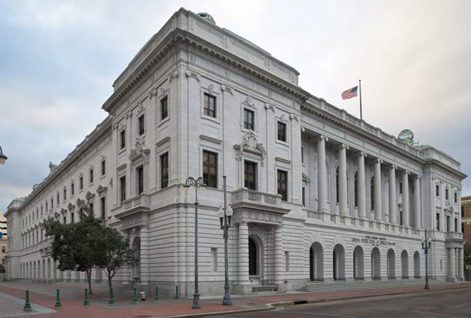
Eighteen federal appellate judges. An 11-6-1 split. A classic fact-based majority decision by conservative icon Judge Patrick Higginbotham. One concurrence joined by six judges. Five separate dissenting opinions – all from fellow conservative jurists. Some of the dissenters even poke at each other. All former trial judges on one side against those who were not.
In all, 75 pages of wisdom from the U.S. Court of Appeals for the Fifth Circuit.
That could only mean one thing: qualified immunity gets its day – again – at the federal court of appeals.
It also means that two Sachse police officers – Michael Hunter and Martin Cassidy – will stand trial in federal court in Dallas for allegations that they used excessive force and fabricated evidence in the 2010 shooting of then-17-year-old Ryan Cole of Garland.
The case raises two fundamental questions that have been in dispute for decades:
- Who holds the power to decide whether government officials get immunity: trial judges, juries or appellate court judges?
- How and when do competing or conflicting facts impact that decision?
In a 22-page majority opinion, Judge Higginbotham – joined by 10 other appellate judges – writes that trial judges should decide at the earliest possible point in a case whether a police officer or other government official should get qualified immunity from being sued for doing their duties on the job.
However, when a trial judge is confronted with significant conflicting factual claims and serious allegations of “fabrication of evidence” by the officials seeking immunity, courts must turn to a system established by the Constitution – the right to trial by jury – to decide if immunity applies, Judge Higginbotham wrote.

“The district court determined that genuine disputes of fact regarding Cassidy’s and Hunter’s entitlement to qualified immunity remain,” Judge Higginbotham wrote. “It will be for a jury to resolve what happened on Oct. 25, 2010.”
Judge Edith Jones, in a dissent that was also 22 pages, said that the majority fails to understand the purpose of qualified immunity, especially as it applies to police officers facing dangers as they did nine years ago with Cole, who was reportedly walking around the neighborhood with a gun and threatening to kill himself.
“Shooting at Cole may not have been the wisest choice under these pressing circumstances, but the officers’ decision, even if assailable, was at most negligent. Hunter and Cassidy were neither plainly incompetent nor themselves lawbreakers,” Judge Jones wrote. “While we are confident a jury will vindicate their actions, they deserved qualified immunity as a matter of law.”
Legal experts say the battle over qualified immunity is not exclusive to the Fifth Circuit.
“There is an ongoing national debate among judges and academics about the durability of the qualified immunity defense, and the Fifth Circuit’s splintered opinions reflect that,” said Haynes and Boone appellate law partner Ben Mesches. “They also confirm that, although many of the newly appointed Fifth Circuit judges share an overarching conservative judicial philosophy, they are not a monolith and are willing to air sharp disagreements in their writings.”
David Coale, an appellate law partner at Lynn Pinker Cox & Hurst, said that it “is no accident that all the former trial judges are on the majority side.” He said the appellate judges who formerly served on trial benches seem more likely to give trial judges more deference.
“This decision actually keeps the pot boiling,” Coale said. “The underlying issue in determining qualified immunity is a balance of power between judge and jury and trial judge versus the appellate judges. In this case, the trial court and jury won the day.”
The incident occurred the morning of Oct. 25, 2010, when Sachse police responded to a call from neighboring Garland to help in the search and apprehension of Cole, who was reportedly suicidal and had a handgun pointed at his own head.
Officers Hunter and Cassidy, in statements made the day of the shooting, were searching for Cole when they confronted the disturbed teenager along a line of trees.
“Ryan was holding his handgun point at his own head, where it remained,” according to court documents. “Ryan never pointed a weapon at the officers and never made a threatening or provocative gesture towards the officers. Officers Cassidy and Hunter had the time and opportunity to give a warning for Ryan to disarm himself. However, the officers provided no warning.
“Ryan was not given an opportunity to disarm himself before he was shot,” court records state. “Hunter and Cassidy then shot Ryan multiple times.”
Judge Higginbotham notes that Cole “was oriented away from the officers at a 90-degree angle – that is he was not facing Officer Hunter.”
“As an involuntary reflex to being shot, Ryan pulled the trigger, shooting himself in his temple. But the officers did not know that,” Judge Higginbotham wrote.
In his decision, Judge Higginbotham repeatedly points out that the two officers changed their stories four years after the incident, suddenly remembering that they heard about Cole’s potential dangerousness – knowledge that they failed to report or acknowledge the day of the shooting.
“Four years later, after this litigation had commenced, Hunter for the first time recalled that the civilian he had overheard had described an altercation with Ryan in which Ryan had threatened him,” Judge Higginbotham opined. “He also then for the first time recalled hearing police-radio transmissions indicating that officers were protecting nearby schools because of [Ryan’s] dangerous conduct which posed a risk of serious harm to a great many innocent in the vicinity.’
“Hunter otherwise learned nothing ‘that would cause [him] to believe [Ryan] was violent or wanted to hurt anyone.’ Hunter understood that Ryan was suicidal, and, four years after the incident, he also raised the possibility that Ryan was using suicide as a pretext to evade the police,” according to the decision.
Judge Higginbotham points out that the officers claimed Cole turned his body toward Hunter and pointed the gun at the officer.
That action by Cole, the officers claimed, left Hunter fearing for his life and led to him shooting Cole for defensive purposes.
The Dallas District Attorney’s Office later learned from a ballistics analysis that Cole shot himself in the head, which experts testified would have made the officers’ statements about Cole waving a gun at them impossible, Judge Higginbotham said.
Judge Jones wrote that the majority of judges are missing key facts in their argument.
“The majority opinion omits or ignores material undisputed facts recited above — the knowledge of the officers, Cole’s turning toward them, the significance of his finger in a loaded pistol, and the three to five second interval — and hides behind the assertion that, relevant to qualified immunity, there are ‘genuine factual disputes as to Ryan’s and the officers’ conduct’ such that a reasonable jury could find that Cole posed no ‘immediate threat’ to the officers or others,” Judge Jones wrote.
“The only legal question that needs to be addressed by this court is whether, under the circumstances of this five-second confrontation, every reasonable police officer would have reasonably perceived no life-threatening danger such that deadly force could be used to incapacitate Cole without a preliminary warning. Put otherwise, as a matter of law, was it clearly established that officers may not fire on a suspect, armed and ready to shoot a pistol, who is turning in their direction with one of their brethren ten to twenty feet away, unless the gun barrel points at them or they first shout a warning and await his response?”
Judge Jerry Smith, in his dissent, wrote that the majority “commits grave error” in its decision.
“Abandon hope, all ye who enter Texas, Louisiana or Mississippi as peace officers with only a few seconds to react to dangerous confrontations with threatening and well-armed potential killers,” Judge Smith stated.
Judge James Ho and Judge Andrew Oldham, in their 11-page dissent, wrote that Higginbotham’s majority opinion “is demonstrably erroneous” and that the “majority does not get it.”
“The panel opinions and en banc majority opinion in this case likewise seethe with innuendo that Officers Hunter and Cassidy were wannabe cowboys looking for a gunfight,” Judges Ho and Oldham stated. “We are in no position to make such accusations.”
“No member of this court has stared down a fleeing felon on the interstate or confronted a mentally disturbed teenager who is brandishing a loaded gun near his school,” the judges wrote.
Judges Ho and Oldham said that the Supreme Court precedent in qualified immunity cases “gives us no basis for sneering at cops on the beat from the safety of our chambers.”

Judge Jennifer Elrod, who joined Judge Higginbotham’s majority opinion, wrote concurrently that the dissenting judges are very misguided.
“Despite the outcry of the dissenting opinions, there is no new law being made or old law being ignored,” Judge Elrod wrote. “The majority opinion takes no position on the public policy issues of the day regarding policing and the mentally ill. Rather, it follows the longstanding en banc rule that ‘we lack jurisdiction to review the genuineness of a fact issue’ on an interlocutory appeal of a denial of summary judgment based on qualified immunity.
“As the able district court determined, the facts are very much in dispute,” Judge Elrod concluded.
Legal experts say that the seven separate opinions are well written and show that the judges do not hesitate to take swipes at each other.
“This is as divided as the Fifth Circuit gets,” said Chris Kratovil, an appellate law partner at Dykema in Dallas. “I cannot remember any longer or more robust dissents in a single case. All of the opinions are thoughtful and strong. If there is a weakness in the dissent, it is that they do not deal with the change of testimony or narrative offered by the police officers.”
But Kratovil said that the dissenting opinions certainly establish a basis for an appeal by the officers.
